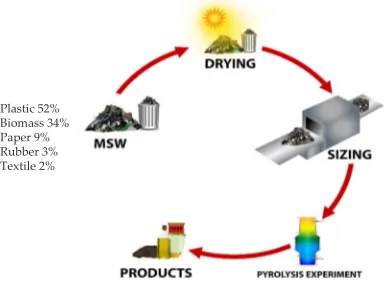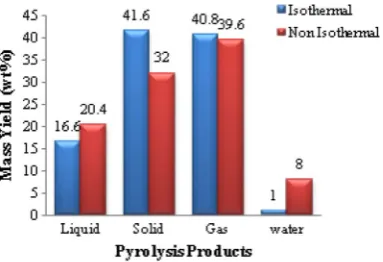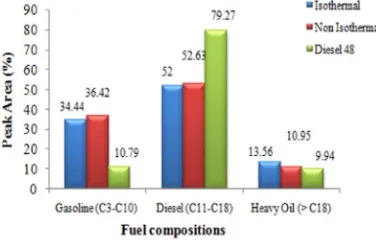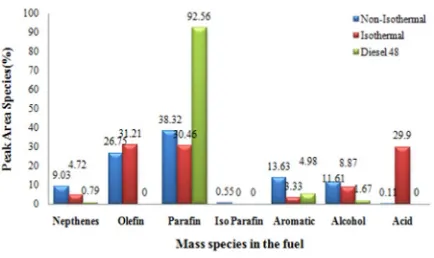Waste (MSW) in Indonesia using non-isothermal and isothermal
experimental
Indra Mamad Gandidi
a,⁎, M. Dyan Susila
a, Nugroho Agung Pambudi
b,caDepartment of Mechanical Engineering, Faculty of Engineering, Lampung University, Jl. S. Brojonegoro No. 1, Bandarlampung, Indonesia bMechanical Engineering Education, Universitas Negeri Sebelas Maret, Jl. Ir. Sutami 36A, Surakarta 57126, Indonesia
cInternational Institute for Carbon-Neutral Reserch (WPI-I2CNER), Kyushu University, 744 Motooka, Nishi-ku, Fukuoka 819-0395, Japan
A R T I C L E I N F O
Municipal solid waste (MSW), disposed of at open dumping sites, poses health risks, con-taminates surface water, and releases greenhouse gasses such as methane. However, pyrolysis offers the opportunity to convert MSW into Bio-Oil (BO) for clean energy resource. In this paper, an MSW sample consisting of plastic, paper and cardboard, rubber and textiles, and vegetable waste is pyrolysed on a laboratory scale in afixed-bed vacuum reactor. In the non-isothermal process, the sample was fed into the reactor and then heated. In the isothermal process, the reactor isfirst heated and then the sample is added. The non-isothermal process created greater BO in both quality and quantity. The BO had a larger amount of gasoline species than diesel-48 fuel, with at 33.44%the BO produced by isothermal pyrolysis and 36.42% in non-isothermal pyrolysis. However the product of isothermal pyrolysis had a higher acid content that reduced its heating value.
1. Introduction
Waste management is an important process in human life with the goal offinding solutions to the issue of waste generated by individuals or industries[1]. In Indonesia, waste management is the responsibility of the provincial and local governments. The treatment of hazardous and toxic waste is regulated by the Regulation No. 74 Year 2001. However,the processing of inorganic waste and Municipal Solid Waste (MSW) are not specifically regulated. According to Wijayanti et al., approximately, the number of waste produced in Indonesia are about 38,5 million ton per year every and it is increase to 2–4% per year. And the data also shows that the highest number of waste source is household (48%), followed by traditional market (24%), commercial area (19%) and public facilities[2].
Municipal solid waste are however classify as domestic waste, domestic waste equivalent and specific wasteandthe management process ends with disposal at an open dumping landfill[3]. There are many disadvantages to the situation, such as site limitations and the spread of disease by insects, pests, and bacteria. Furthermore, MSW can contaminate surface water through leaching[3]. As it degrades biochemically, MSW will releases methane gas into the atmosphere. Therefore, MSW is consideredone of the major contributors to the greenhouse effect, increased global warming, extreme weather andfloods[4,5]. And an estimated 900 t of methane is emitted every year from solid waste dumpsites through Indonesia[6]. The lanslade disaster in open dumping site at Bandung city in Indonesia is occurred and killing 140 persons[7].
http://dx.doi.org/10.1016/j.csite.2017.08.003
Received 30 May 2017; Received in revised form 13 August 2017; Accepted 23 August 2017 ⁎Corresponding author.
E-mail addresses:indra.mamad@eng.unila.ac.id(I. Mamad Gandidi),agung.pambudi@staff.uns.ac.id,pambudi@i2cner.kyushu-u.ac.jp(N. Agung Pambudi).
Available online 24 August 2017
However, MSW is a material has a high energy content. MSW is a material that has energy potential in the form of chemical bonds between molecules of carbon, hydrogen and oxygen. When its chemical bonds are broken, the organic material releases the chemical energy in the form of a gas, liquid or solid which is commonly called biofuel[8,9]. Therefore there is an opportunity to convert MSW into a valuable bio-energy. There are several methods for bio-energy production from MSW, and pyrolysis is one popular method in utilizing of MSW[10–19]. The method is a thermal degradation in which MSW is converted into a mixture of solids, liquids and gases at an elevated temperature without the presence of oxygen[11]. The focus of this initial research is to conduct the pyrolysis process of MSW to produce BO.
1.1. MSW pyrolysis processes
Historically, pyrolysis has been used to make coke from coal for metallurgy uses, especially steel making[20]. In the modern day, it is the basis of several methods being developed to produce fuel from biomass. In this case, pyrolysis technology offers the op-portunity to convert municipal solid wastes into Bio-Oil (BO), which would be attractive not only as a waste disposal solution but also for the clean energy production. This BO is easily stored, transported, and upgraded and can be used in diesel engines and even gas turbines to generate electricity[21]. In co-firing applications, it is easier to handle and burn than solid fuel as well as less expensive to transport and store. Additionally, pyrolysis of MSW produces a solid residue, char, which is almost pure carbon and can be utilized in activated carbonfiltration for water treatment applications or as an agricultural soil amendment[22,23].
Pyrolysis involves a process of thermal degradation under high temperatures, which range around 200–900 °C. In this research, the MSW sample to be pyrolysis consists of various organic substances including vegetable waste from the traditional market, garden and household waste, low and high-density polyethylene (LDPE, HDPE), paper and cardboard, rubber and textile waste. These different substances were unseparated in the sample as it was dried in the sun for 3–5 days as shown inFig. 1. Afterwards, the MSW was separated to account for its composition before being chopped into small pieces between 5–10 cm, the appropriate size for the reactor capacity. The composition (dry basis) and physical form of the MSW is shown inFig. 1. Just over half of the MSW consisted of plastic waste like bottles and plastic bags. Another third was made up of biomass, mostly vegetable waste from the market, gardens and kitchens. Almost a tenth consisted of discarded paper, newspapers, and cardboard, while 3% was rubber waste and 2% was discarded textiles.
2. Materials and methods
The pyrolysis experiment method on a laboratory scale employed afixed-bed vacuum reactor. The reactor was a stainless steel cylinder, 310 mm in height and 160 mm in width, with an electrical heating jacket. The reactor was set vertically and nitrogen gas was introduced for 3 min from the top. Thisflow of nitrogen was to replace the air inside, creating the necessary vacuum conditions for a pyrolysis reaction. Afterwards, the nitrogenflowed out through the top of the reactor again.
Two pyrolysis processes were used in this experiment: non-isothermal and isothermal. In the non-isothermal pyrolysis, 500 g of the MSW sample was fed into the reactor. Once the MSW sample was added, the reactor and its contents were heated to 400 °C. However, in the isothermal process, the reactor wasfirst heated to 400 °C and then the 500 g of sample was loaded. In both cases, the reaction time was 60 min. The complete experiment process is shown inFig. 2.
The gas produced from the pyrolysis flows to vacuum gas cleaner through the top of the reactor. It thenflows to thefirst condenser as a gas cleaner. A secondary condensers is also employed to separate the permanent gas and bio-oil (BO) at temperature 20 °C. The gaseous product is a mixture of BO and water, which were separated by precipitation andfiltration processes. The char produced from the pyrolysis remained in the reactor to be collected after the reaction. The BO collected from the experiment was then analysed. Initially, it was weighed with SF-400 electronic scales to determine the mass yield. Furthermore, mass fraction analysis was conducted using a gas chromatography-mass spectrometry (GC-MS, QP2010S Shimadzu). The column was DB-1 (Agilent J 100% dimethylpolysiloxane) capillary column, 30 m length with 0.25 mm diameter and 25-μmfilm thickness. Helium was used as the gas
carrier. The temperature was initially set at 60 °C for 5 min, followed by a heating rate of 5 °C/min to 280 °C, where it was held for 51 min.
3. Results and discussion
3.1. Mass yield product
The mass yield of products from the pyrolysis is shownFig. 3. The non-isothermal process has a higher BO product than the isothermal, although both pyrolysis treatments resulted in a significant amount of solid residue due to the brief reaction time and long residence time of the gas[23]. The isothermal process left behind more residue than the non-isothermal process. It has been proved that MSW degradation by non-isothermal pyrolysis at high temperature leads to a good conversion rate. The high and increasing temperature contributed significantly to dilute chemical bonds in the MSW before it reached thefinal temperature. Consequently, cracking took place easily at the top of temperature and it resulted in higher BO production. However, water was obtained from non-isothermal pyrolysis in a greater amount than from the non-isothermal pyrolysis because of the slow pyrolysis process. The significant presence of syngas in the pyrolysis product showed that the condensation temperature of around 20 °C was not favorable and reduced the liquid product. It is recommended to carry out the condensation of bio-oil at lower temperatures.
Fig. 2.The experimental setup.
3.2. Chromatogram mass fraction analysis
Based on petroleum mass fraction, BO from MSW pyrolysis can be divided into three kind of fuel, namely naphtha fuel (C3–C10), diesel fuel (C11–C18) and heavy oil (> C18). The amount of BO in each range is represented by GC-MS peak area inFig. 3(a), and the percent of each BO range is shown inFig. 3(b). Clearly, each pyrolysis method produces somewhat different amounts in each carbon range.(Fig. 4)
3.3. Mass fraction comparison
Between BO and conventional fuel, its characteristics compare well with the conventional fuel regarding the carbon number distribution. It can be seen that the BO is in some ways better than the diesel-48 fuel because it has a greater amount of gasoline species. The difference was around 227.5% for the isothermal pyrolysis and 237.5% for non-isothermal pyrolysis, as shown inFig. 5. The presence of waste plastics in the MSW such as HDPE and LDPE contributed to produce gasoline content in the BO. This is strong evidence that BO from MSW pyrolysis can replace diesel-48 fuel as a future energy source.
3.4. Mass species comparison
Regarding mass fraction in each range of fuel, the presence of many oxygenated functional groups and aromatics substances shown inFig. 6. Higher acid content and a higher fraction of oxygenated compounds in the substance will reduce the calorific value of the oil, since carbon-oxygen bonds do not release energy during combustion. BO from non-isothermal pyrolysis has a large amount in
Fig. 4.Chromatogram of the BO mass fraction; (a) Non-isothermal pyrolysis; (b) Isothermal pyrolysis.
the paraffin contents, while BO from isothermal pyrolysis has a large acid content. This indicates that the BO from non-isothermal pyrolysis has a heating value higher than the BO from isothermal pyrolysis.Fig. 5also shows a comparison of mass species between BO from pyrolysis and diesel-48 fuel. The diesel-48 mostly contains paraffin and BO non-isothermal contains mainly paraffin and olefin as well as nepthenes. This indicates that it is of better quality than the diesel-48 due to light hydrocarbon content. Meanwhile, the presence of acid in BO from isothermal pyrolysis indicates that is the lower quality oil.
4. Conclusions
The non-isothermal process in which the sample is heated inside the reactor produced more BO product than the isothermal process, and the oil was of higher quality. The oil produced by the isothermal process had a higher acid content that reduces the oil's calorific value. In contrast, the non-isothermal pyrolysis produced a larger paraffin content (38.2%), nepthenes (9.03%), olefin (26.75%), and aromatic compounds (12.63%) as well as alcohol (11.61%). The products are more diverse than in diesel-48, which consists primarily of paraffin (92.56%) with trace aromatics and alcohol, and have lighter hydrocarbon content. As well, both non-isothermal and non-isothermal pyrolysis produced a higher amount of gasoline species. Compared to conventional fuel, then, bio-oil produced by pyrolysis compares favorably in many ways, especially from the non-isothermal process. This is likely thanks to the presence of waste plastics, which made up nearly half of the MSW mass. MSW with larger percentages of plastics appears most valuable for bio-oil production. However, the bio-oil produced through this process does contain impurities. Before BO from MSW can be widely used as a clean fuel, it will be necessary to develop ways to purify and upgrade it. Future research will be in this area.
References
[1]E. Pongrácz, Re-defining the Concepts of Waste and Waste Management: Evolving the Theory of Waste Management, Faculty of Technology, University of Oulu, Finland, 2002.
[2]D.R. Wijayanti, S. Suryani, Waste Bank as community-based environmental Governance: a lesson learned from Surabaya, Procedia–Soc. Behav. Sci. 184 (2015) 171–179. [3]M.M. Abd El-Salam, G.I. Abu-Zuid, Impact of landfill leachate on the groundwater quality: a case study in Egypt, J. Adv. Res. 6 (4) (2015) 579–586.
[4]H. Mohajan, M.P. RA Dangerous, effects of methane gas in atmosphere, Int. J. Econ. Polit. Integr. 3 (2011).
[5]H.B. Dulal, S. Akbar, Greenhouse gas emission reduction options for cities:finding the‘Coincidence of Agendas' between local priorities and climate change mitigation objectives, Habitat Int. 38 (2013) 100–105.
[6] Urban Sanitation, City Master Planning, The Solid Waste Challenge, Sanitation BLUDs, Adapting Hibah Grants to Sanitation, Infrastructure Enhancement Grants, Australia Indonesia Partnership, Issue 7 July, 2011.
[7]M. Chaerul, M. Tanaka, A.V. Shekdar, Municipal solid waste management in indonesia: status and the strategic actions, J. Fac. Environ. Sci. Technol. 12 (1) (2007) 41–49. [8] Ebru AKKAYA, Ahmet DEMIR, Energy content estimation of municipal solid waste by multiple regression analysis, in: 5th International Advanced Technologies Symposium
(IATS’09), May 13–15, 2009, Karabuk, Turkey, 2016.
[9]P. McKendry, Energy production from biomass (part 1): overview of biomass, Bioresour. Technol. 83 (1) (2002) 37–46.
[10]S. Zahedi, R. Solera, J.L. García-Morales, D. Sales, Effect of the addition of glycerol on hydrogen production from industrial municipal solid waste, Fuel 180 (2016) 343–347.
[11]N. Couto, V. Silva, A. Rouboa, Municipal solid waste gasification in semi-industrial conditions using air-CO2mixtures, Energy 104 (2016) 42–52.
[12]I. Velghe, R. Carleer, J. Yperman, S. Schreurs, Study of the pyrolysis of municipal solid waste for the production of valuable products, J. Anal. Appl. Pyrolysis 92 (2) (2011) 366–375.
[13]T. Malkow, Novel and innovative pyrolysis and gasification technologies for energy efficient and environmentally sound MSW disposal, Waste Manag. 24 (1) (2004) 53–79. [14]M. He, et al., Syngas production from pyrolysis of municipal solid waste (MSW) with dolomite as downstream catalysts, J. Anal. Appl. Pyrolysis 87 (2) (2010) 181–187. [15]A. Li, et al., Experimental studies on municipal solid waste pyrolysis in a laboratory-scale rotary kiln, Energy 24 (3) (1999) 209–218.
[16]A. Gallardo, M. Carlos, M.D. Bovea, F.J. Colomer, F. Albarrán, Analysis of refuse-derived fuel from the municipal solid waste reject fraction and its compliance with quality standards, J. Clean. Prod. 83 (2014) 118–125.
[17]M. Wilewska-Bien, M. Lundberg, B.-M. Steenari, H. Theliander, Treatment process for MSW combustionfly ash laboratory and pilot plant experiments, Waste Manag. 27 (9) (2007) 1213–1224.
[18]J. Lédé, Biomass pyrolysis: comments on some sources of confusions in the definitions of temperatures and heating rates, Energies 3 (4) (2010) 886–898.
[19]A. Paethanom, K. Yoshikawa, Influence of pyrolysis temperature on rice husk char characteristics and its tar adsorption capability, Energies 5 (12) (2012) 4941–4951. [20]D. Mohan, Pittman Charles U, P.H. Steele, Pyrolysis of wood/biomass for bio-oil: a critical review, Energy Fuels 20 (3) (2006) 848–889.
[21]S. Czernik, A.V. Bridgwater, Overview of applications of biomass fast pyrolysis oil, Energy Fuels 18 (2) (2004) 590–598. [22]P.V. Duck, V.D. Voorde, Activated charcoal and microflora in water treatment, Water Resour. 18 (11) (1984) 1361–1364.



